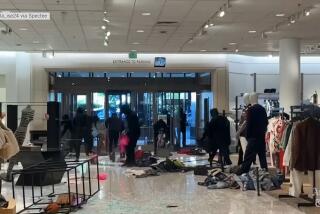Sure, Workers Get Mad, but More Getting Even
SAN FRANCISCO — Call it work rage. As the corporate world slims down, speeds up and grows more uncertain, workers are getting mad. Anger at employers is getting more pervasive, security experts say, in a job market where few people expect to finish a career where they began it.
Resentment usually surfaces in the traditional form of griping. But increasingly, it is playing itself out in a darker fashion--sabotage.
Most managers don’t want to even talk about their workers who deliberately inflict damage on the job. Few companies have worked out programs to anticipate and deal with the problem. But employee sabotage is costing American corporations hundreds of millions, if not billions, of dollars every year, and it is being carried out by everyone from dock workers to corporate vice presidents.
Just ask Dennis Dalton, president of security firm Dalton Affiliates in Fremont, Calif.
Hired recently to find out who was carving graffiti into the imported hardwood that lined one of San Francisco’s best-known downtown skyscrapers, Dalton set up security cameras in the elevators and posted signs outside warning riders they were being monitored.
The security consultant, a veteran of the business, could hardly believe what the videotapes recorded. Vandals repeatedly gouged profanity-laden hate messages into the wood, forcing the office tower’s owners to spend hundreds of thousands of dollars replacing paneling.
Both the building’s owners and Dalton initially believed they were looking for outsiders, people who did not actually work in the building.
“There were a group of bicycle messenger folks that we strongly suspected were the primary people,” Dalton recalls. Instead, “we caught office workers using pocket knives and other instruments on the wood,” he says. “It ran across the spectrum . . . to our chagrin and surprise, up popped a professional white-collar employee.” All but two of the many vandals the cameras recorded, he says, were employed by firms whose offices were in the skyscraper.
Companies Find the Enemy Within
In another instance, Dalton says, owners of a Boston high-rise wanted him to find out who was defacing elevators lined with imported marble.
“Again, we put in cameras, this time hidden--with a court order. We found that the vandals were dock workers, secretarial-computer people, computer workers. And then we caught a vice president who wrote graffiti on the elevator’s marble in response to the nasty messages from the employees. At that point, you think, ‘This is getting bizarre.’ ”
The lesson to be learned, Dalton says, is one a lot of managers have trouble accepting: Employee sabotage in the workplace is a common occurrence and can range from the most simple acts of vandalism to complex acts of technological revenge.
Employee sabotage, particularly in the Information Age, “is a huge issue,” says Barbara J. Bashein, professor of information systems at California State University at San Marcos.
A specialist in computer systems and controls, Bashein wrote a report this year for the Financial Executives Research Foundation on internal corporation controls over technology. One of the things she learned, Bashein says, “is that a lot of managers believe [employee sabotage] won’t happen to them. Our research showed that the reality is that it will happen to you because it happens to most organizations.”
It can be as simple as the angry employee who uses his car key to scrape paint off a row of cars in the company parking lot, security specialist Dalton says, or as complex as the computer technician who plants a virus in the company’s system as her final act before taking a new job.
In San Francisco a year ago, a power failure at a key downtown substation of the Pacific Gas & Electric Co. plunged one-third of the city into darkness for several hours and hopelessly snarled the morning rush-hour commute. Within hours of the blackout, PG&E; and local law enforcement officials were declaring it an act of sabotage--someone had turned a long row of knobs in the substation to cut the power.
At the time, PG&E; was struggling with the adjustments caused by the deregulation of utilities in California. Employees who had long counted on job security were suddenly faced with the realities--and stresses--caused by jumping into a competitive market.
From the beginning, both PG&E; and local law enforcement officials said employees were the primary suspects because access to the substation was restricted and no one had broken in. The FBI says the case is still under investigation. No arrests have been made.
Often, acts of employee sabotage go unreported and unpunished, according to Richard Power, a spokesman for Computer Security Institute in San Francisco. The institute is an association of information security specialists with 5,000 members worldwide, Power says.
“It happens far more times than you read about in the newspaper,” Power says. “Any computer crime is very rarely reported because companies don’t want the publicity. They don’t want to draw attention to the vulnerability of their networks--they don’t want to alarm stockholders.”
At PG&E;, officials say they are frustrated by the fact that no one has been arrested in the substation case, but they add that employee sabotage is low on their list of security concerns.
“The last incident of the type that occurred at the substation occurred 15 years ago,” says Lyman Shaffer, head of corporate security for PG&E.; “We don’t regard sabotage as a serious issue at our company.”
But Power says such crimes are growing more common--and potentially more costly to companies--as reliance on interconnected computer systems grows.
“The more and more our systems are networked and businesses rely on online communications, the more of a problem sabotage becomes,” he says.
One of the largest known instances of employee computer sabotage in this country was uncovered just this year, at Omega Engineering, a New Jersey company.
Timothy A. Lloyd is expected to stand trial by the end of this year, charged with planting a computer “bomb” that deleted software essential to Omega’s operations.
Federal prosecutors have estimated the sabotage cost Omega more than $10 million in sales and contracts. Lloyd had been a programmer at the company who lost his job. He is charged with deliberately destroying his companies computer files.
Job Insecurity Shakes Workplace Security
In its 1997-98 Intellectual Property Loss Special Report, the American Society for Industrial Security said 89% of respondents to its survey said their biggest concern about system security was retaliation from disgruntled employees.
Entire security industries are being spawned by the growing fear of employee sabotage, says Dalton, the security specialist. But he says that he and other security firms tell corporations that increased security alone cannot prevent such acts.
“I’ve been in this business for 30 years, and there is far more employee sabotage now than there was even 20 years ago,” Dalton says. “Regardless of what you might read in management textbooks, there is a correlation between the level of corporate disenchantment between employees and their bosses and the willingness to commit sabotage.”
As company mergers and downsizing have become commonplace and job security rare, Dalton says, instances of employee sabotage have multiplied.
“When I do strategic planning for corporations,” Dalton says, “one of the chief things we look at is how to develop sound employee relationship programs--how to announce layoffs, acquisitions or mergers, how to tell people you’ll be closing a plant or relocating it. We call it asset protection from a prevention standpoint.”
More to Read
Inside the business of entertainment
The Wide Shot brings you news, analysis and insights on everything from streaming wars to production — and what it all means for the future.
You may occasionally receive promotional content from the Los Angeles Times.










